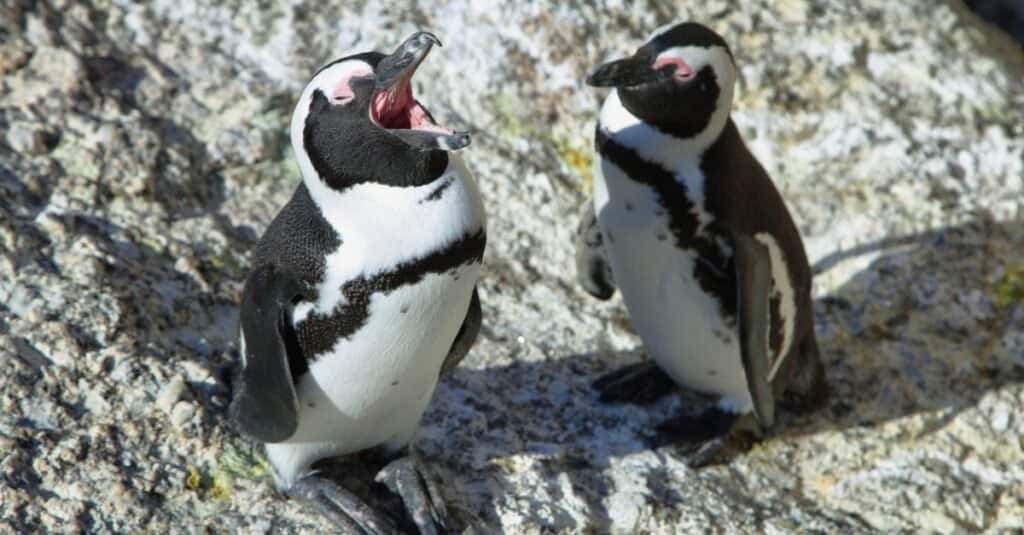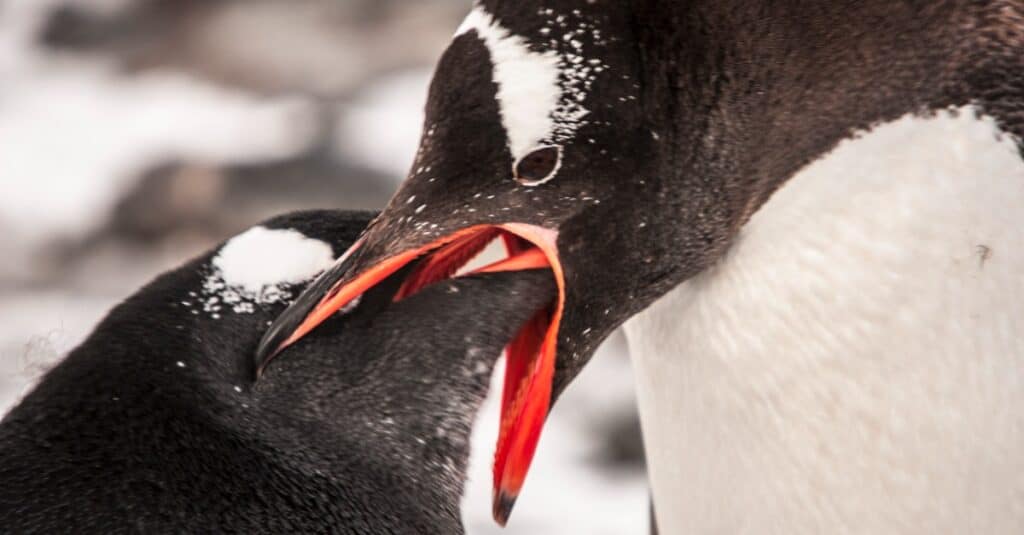Do you like penguins? Most people would answer yes to that question. These birds are fun to watch as they dive into the ocean or waddle along the shores of Antarctica. Though there are a lot of interesting facts about penguins, one of the most intriguing tidbits of information has to do with how they eat.
Read on to learn the answer to this question: Do penguins have teeth? You may be surprised at the answer. Also find out what penguins eat, what determines their diet, and the incredible way they digest their food.
Do Penguins Have Teeth?

©iStock.com/estivillml
No, penguins don’t have teeth. Look at a picture of a penguin with its beak open and you’ll see rows of small, pointy growths. It’s easy to assume those are rows of teeth, but they aren’t.
What Are the Pointy Growths Inside a Penguin’s Mouth?
They are actually serrated spines. These fleshy spines grow in rows and bend inward, toward the throat of a penguin. They bend inward to allow prey to slide easily down the throat of this bird. In fact, a penguin purposely eats a fish head first, so its fins won’t get stuck on the way down. If a fish or other prey is wiggles or tries to get out, it is caught on the serrated, or barbed spines. Picture a fish hook with a barb on it designed to snag a fish so it doesn’t slide away. These barbed spines ensure a penguin doesn’t lose the prey it’s worked so hard to capture.
What Do Penguins Eat?
Penguins eat a lot of small creatures in the ocean. They eat tiny crustaceans called krill. Krill look a lot like shrimp. Penguins also eat squid and, of course, fish. Some penguins can eat a small octopus. Keep in mind that different types of penguins eat different kinds of fish. For instance, king penguins eat a large amount of herring while Galapagos penguins eat mullet fish.
The size of a penguin has a lot to do with the size of the prey it eats. The largest type of penguin, the emperor penguin, eats lantern fish that can grow to 11.81 inches in length. Alternatively, small Humboldt penguins have a diet of sardines. Sardines are tiny measuring a few inches long.
When you think about it, large penguins eat bigger prey because they need more nourishment for their bodies.
The diet of a penguin also depends on where it lives. Penguins that live in the Antarctic eat mostly krill because that’s what is most plentiful in those cold waters. Alternatively, penguins living in areas with warm water eat a large supply of fish.
Do Penguins Chew Their Food?
No, penguins don’t chew their food. The spines in their mouth allow them to swallow their prey whole. But how do they digest a whole fish or squid? The answer to this question has something to do with pebbles.
Why Do Penguins Swallow Pebbles?

©iStock.com/atese
Penguins don’t chew their food, but they do swallow pebbles. This is one of those facts that sounds very strange, but it’s true.
Penguins swallow pebbles of all sizes for a reason. The pebbles help to break down the various parts of a fish or other prey so they can be digested in the bird’s stomach.
This method of digestion isn’t unique to penguins. Other birds such as ostriches, crows and even chickens swallow pebbles to aid their digestion. If you own a parakeet, you put something called grit into its cage. This grit serves the same purpose for a parakeet that a pebble does for a penguin. A parakeet eats the grit so it can break down the seed the little bird eats each day.
What Happens to the Pebbles a Penguin Swallows?
The pebbles move around and around when helping to break down a penguin’s food in its system. With all of this movement, the pebbles take on a smooth surface. Small pebbles eventually dissolve with this activity. However, larger pebbles may move all the way through a penguin’s digestive system and leave the bird’s body when it poops. In addition, there are scientists who have found pebbles in the stomachs of dead penguins.
Why Do Penguins Shake Their Head After Eating?
Have you ever watched a nature program about penguins? If so, you probably saw one or more of these birds pointing its beak straight up and shaking its head. Well, the reason behind this motion is one of the most interesting facts about this sea bird.
The beak of a penguin contains a supraorbital gland that absorbs the salt from the fish and water that go into its mouth when it eats. When a penguin shakes its head or makes a sneezing sound, it’s releasing the salt from that gland. The presence of this gland prevents a penguin from taking in too much salt and becoming dehydrated as a result.
Do Penguins Have a Sharp Beak?
Yes, a penguin has a sharp beak. A penguin’s beak helps it capture krill, squid, and fish. The curved end of this bird’s beak is also helpful in grabbing prey.
Specifically, a penguin dives into the water and grabs prey in its beak on the way down. As a note, some penguins can dive as deep as 1,600 feet in the ocean! That gives them access to a large supply of prey. Just imagine how easy it would be for a penguin diving through a large school of fish to grab one and hold it in its beak in order to swallow it.
Do Young Penguins Have Teeth?
So, if full grown penguins don’t have teeth, do young penguins have them? No, young penguins don’t have teeth either. But they do have something called an egg tooth.
An egg tooth is a pointed structure that looks kind of like a tooth, but it’s more like a small horn growing on top of a young penguin’s beak. They use this hard ‘tooth’ to help them break through the egg’s shell when they are hatching. The shell of a penguin’s egg is very sturdy, so the babies need something sharp to help them crack through it. The egg tooth eventually breaks off after serving its purpose.
How Does a Baby Penguin Take in Nourishment?

©iStock.com/Sahil Yadav
Newborn penguins also called nestlings, are completely dependent on their mothers for a few months. After swallowing prey along with some pebbles to digest it, a mother feeds her nestlings. She does this by regurgitating, or throwing up the prey she eats into the beaks and down the throats of her fuzzy nestlings.
Some species of penguin are able to eat prey and store the food in their stomach for more than a day until it’s fully digested. Then, they can regurgitate it to feed their young. Though this seems like kind of a disgusting process to humans, it’s the perfect way for a penguin nestling to take in the type of nourishment it can digest.
As the penguin nestlings grow, they are taught how to capture their own prey and eat pebbles to digest what they catch. They stay with their mother until the age of five or six months when they can survive independently.
Can the Spines in a Penguin’s Mouth Cause Injury to a Human?
If you like to visit your local zoo, you may have seen the penguins being fed by a zookeeper. Have you ever wondered if they bite the zookeepers who feed them? And if the answer is yes, do the spines inside their mouths injure the zookeepers?
Well, zookeepers are occassionally bitten by penguins. However, it’s usually because the penguins are very excited about mealtime and unintentionally bite the zookeepers! The spines in a penguin’s mouth can scratch a zookeeper and may even break the skin. However, coming in contact with a penguin’s beak is another story.
A penguin has a sharp beak with a curved end. It could certainly injure a person if they were grabbed or pecked by a penguin. This is one reason why zookeepers wear gloves when feeding a bunch of penguins! The other reason they wear gloves is they are handling a supply of dead fish.
A penguin uses its sharp beak as a defense against predators as well. For example, an African penguin may use its beak to defend itself against a sea gull, mongoose or a caracal.
Male penguins use their beaks to fight or compete with other males for females during mating season. These can be very aggressive competitions with pushing and pecking at one another. They are fighting to find out which male is stronger and healthier. Their beaks can certainly cause injury to other penguins.
Up Next…
Keep reading these posts for more incredible information about key animal facts.
- What Do Penguins Eat? Are they carnivorous or do they occasionally indulge in herbivorous delights? What flavors are they capable of tasting? The answers to these questions and more are provided here
- Are Penguins Mammals? Do they have teeth? Or fur? And what is that milk-like substance with which they feed their chicks? Click on the link to read the answers.
- What Do Flamingos Eat? Are they strictly carnivorous? Would they turn up their noses at vegetation? Read all about what they love to eat in this post.
The photo featured at the top of this post is © iStock.com/anyaberkut
Thank you for reading! Have some feedback for us? Contact the AZ Animals editorial team.






